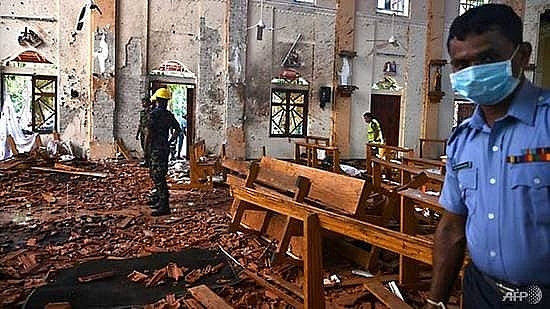Scale of Sri Lanka blasts exceeds Bali bombings, Mumbai attacks
 |
| Security personnel inspect the interior of St Sebastian's Church in Negombo, a day after the church was hit in series of bomb blasts targeting churches and luxury hotels in Sri Lanka. (Jewel SAMAD/AFP) |
With 290 people dead and about 500 injured, the number of casualties is considerably higher than the Bali bombings and Mumbai attacks.
The 2002 Bali bombing in Kuta attributed to Jemaah Islamiyah resulted in 202 people dead and 209 injured. Three years later, the bombing in Jimbaran and Kuta claimed the lives of 20 people and injured 100 others.
The death toll for the Sri Lanka attack is also more than the 2008 Mumbai shooting and bombing attack which lasted four days. The blitz on a railway station, hotels and taxis carried out by Lashkar-e-Taiba, a militant organisation mainly operating out of Pakistan, killed more than 170 people and wounded more than 300.
In 2006, a series of seven bomb blasts shook Mumbai's rail network, killing 209 people and wounding over 700.
The Sri Lankan government has imposed a state of emergency after it blamed a local extremist group, called the National Thowheeth Jama'ath, for the blasts and is investigating if the group had "international support".
On Monday, an explosion hit near a church in Colombo, as police tried to defuse a new bomb found at the site. Meanwhile, the US State Department said "terrorist groups" were continuing to plot possible attacks.
HISTORY OF VIOLENCE
A civil war erupted in the 1980s, with minority Hindu Tamil groups, which had suffered systemic prejudice, launching attacks on the Sinhalese Buddhists.
The Tamil Tigers, an armed insurgent group carried out a series of attacks, including suicide bombings. The Sri Lankan army responded with brutal campaigns, mostly aimed at the Tamil stronghold in the northeast.
On Jun 11, 1990, the Tamil Tigers were said to have massacred over 770 unarmed police officers in the Eastern Province. It was the deadliest terror incident in the South Asian nation.
The civil war ended in 2009 after a large-scale operation by the army that defeated the Tamil Tigers. More than 70,000 people are estimated to have died in the conflict.
Despite the end of hostilities, sectarian divide has continued to grow, especially with the rise of Sinhalese Buddhist nationalism.
Security experts noted that Sunday's attacks, which involved a high degree of sophistication, bore the hallmarks of militant groups Islamic State or Al Qaeda.
"These synchronised attacks are out of the ordinary for Sri Lanka. Compared with similar attacks in the Middle East and Southeast Asia, it has the DNA of attacks carried out by Islamic State and Al Qaeda," said Mr Alto Labetubun, an anti-terrorism expert who has researched the two groups for a decade.
No group has stepped forward to claim responsibility for the attack.
The history of conflict in Sri Lanka also means it was possible for the perpetrators to have access to weapons and explosives. It is also likely that foreign actors were involved.
"With this scale of attacks, I don't think this was only carried out by locals. There is most likely involvement of foreign groups or people, including people moving in and out of India or Pakistan," said Mr Labetubun.
The deadliest terror attack in world history was the Sep 11, 2001 attack planned by Al Qaeda, targetting the US. Almost 3,000 people were killed and 6,000 people injured. More than US$10 billion worth of property and infrastructure are said to have been destroyed.
What the stars mean:
★ Poor ★ ★ Promising ★★★ Good ★★★★ Very good ★★★★★ Exceptional
Related Contents
Latest News
More News
- 72 nations sign landmark Hanoi cybercrime convention (October 26, 2025 | 18:00)
- UN Secretary-General commends Vietnam’s global leadership (October 26, 2025 | 09:00)
- APEC finance ministers convene to tackle regional challenges (October 22, 2025 | 17:31)
- Rewiring global trade: ASEAN’s rise as supply chain hub (October 17, 2025 | 11:40)
- Vietnam attends first World Nuclear Week Forum in Russia (September 26, 2025 | 10:50)
- Vietnam attends 69th session of IAEA General Conference (September 16, 2025 | 10:00)
- ADB, WB pledge over 12 billion USD for ASEAN power grid, renewable energy projects (August 15, 2025 | 14:18)
- Lowy Institute proposes AI-based tobacco control solutions for ASEAN (August 15, 2025 | 14:14)
- Cloud computing policy to position Malaysia as regional hub by 2030 (August 15, 2025 | 14:11)
- Thailand, Cambodia suffer numerous cyber attacks (August 05, 2025 | 16:19)

 Tag:
Tag:






















 Mobile Version
Mobile Version